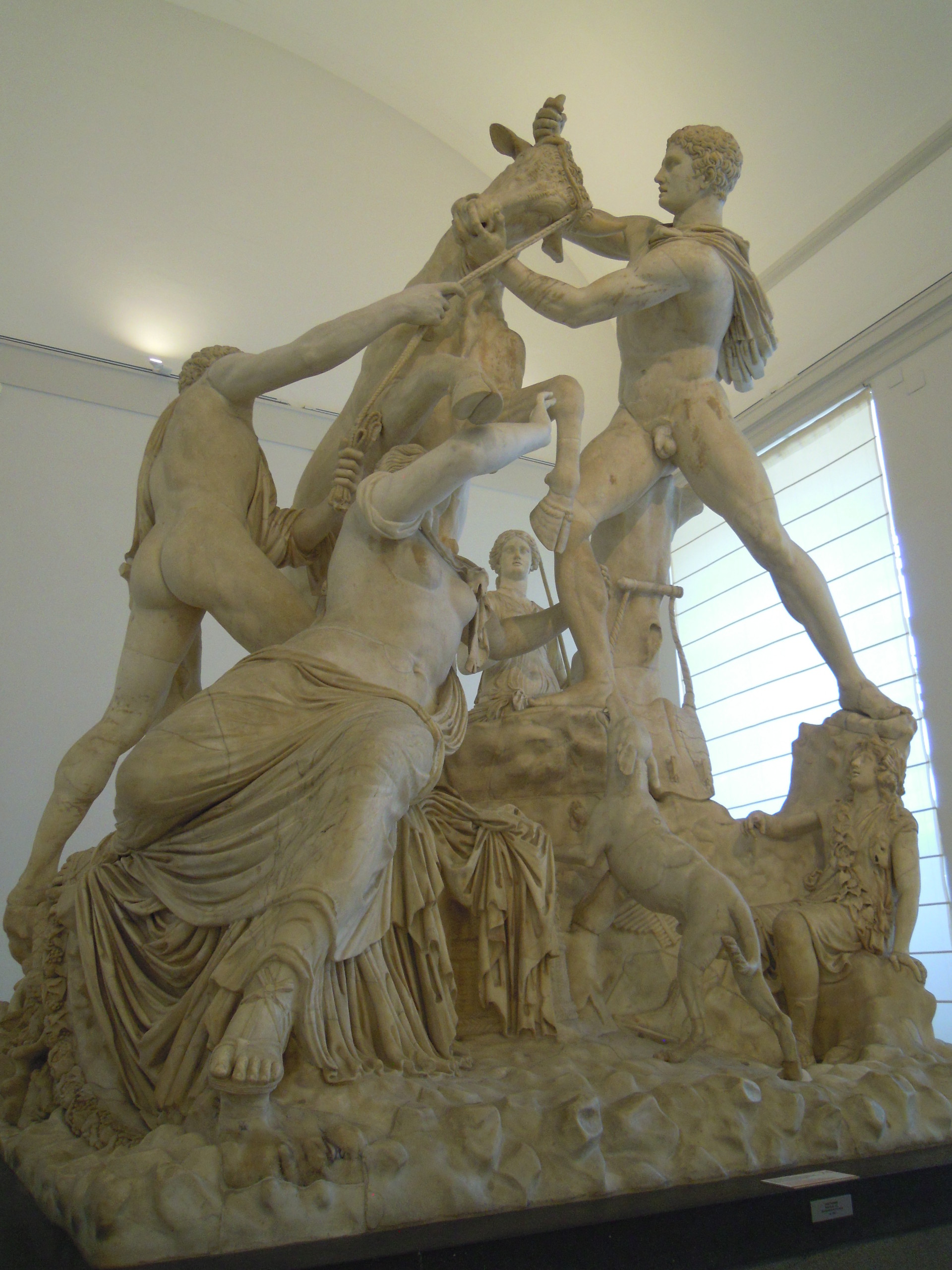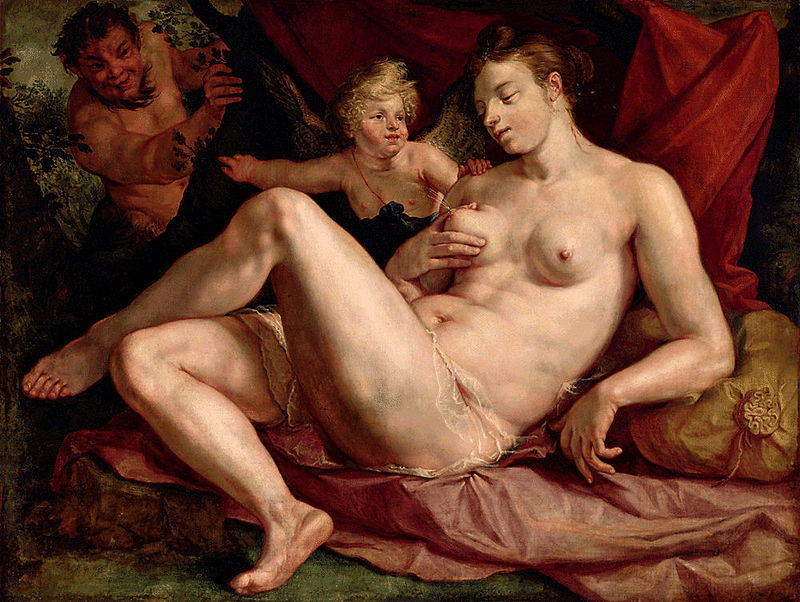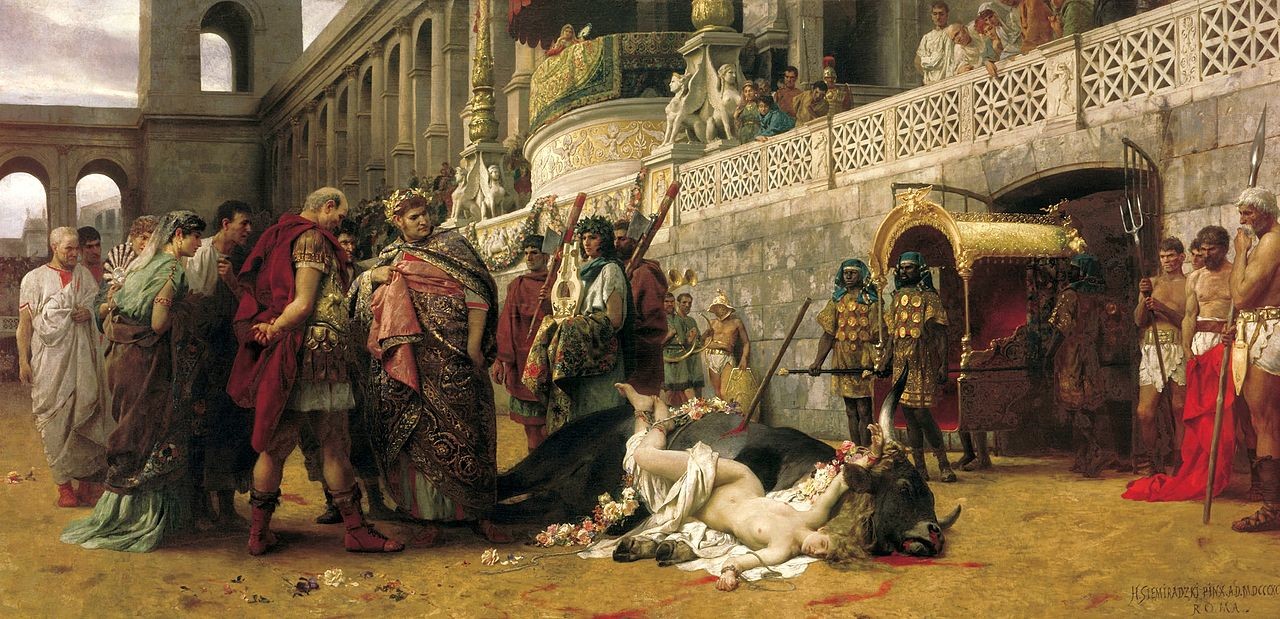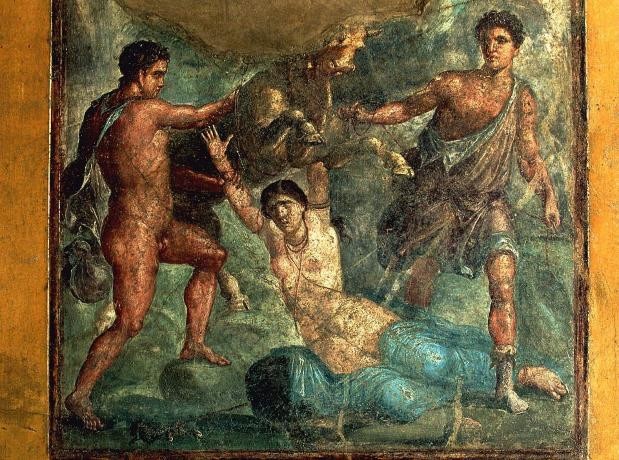The "Toro Farnesio" Sculpture
 The "Toro Farnesio" sculpture in the Archeological Museum of Naples
The "Toro Farnesio" sculpture in the Archeological Museum of Naples
The work "Toro Farnesio" is a group of sculptures of Greek Hellenistic Art (323-31 BC) and, in particular, to the Hellenistic Baroque era (225 –150 BC), which began with the "Niké of Samothrace". Although the most outstanding work of Greek Hellenism is the "Laocoonte", this sculptural work should not go unnoticed with its remarkably large dimensions, the complexity of the composition and the fact that the whole work was carved from the same block of marble: it is the largest sculpture of encrusted enamel from antiquity, being almost four meters high, about three meters wide and weighing almost twenty-four tons.
A little history...
The Hellistic period began in the 4th century BC and it was during this period that Greece lost its independence after being conquered Philip II of Macedonia, who annexed the many nearby city-states to his empire. Until the death of Philip II, his son, Alexander the Great, increased his dominions by conquering the Persian Empire (the former enemy people of the Greeks), including Egypt, Mesopotamia and reaching as far India. Alexander aimed to create a global superpower that would integrate Greeks and barbarians (what they would call foreigners), in which the diverse beliefs and cultures of the West and East could merge. However, In 323 BC Alexander the Great died, leaving a vast empire behind in which he had spread Greek culture and ideas within the conquered territories, giving rise to what is known as Hellism.
After Alexander's death, his generals divided his empire, creating the so-called Hellenistic Kingdoms (Egypt, Syria, and Mesopotamia), which flourished until they were taken over by Rome. The last of these independent states was Egypt, which disappeared upon Cleopatra's death. By then, the Romans had seized all of the territories that had belonged to the Greeks, integrating them into their empire as provinces.
It was then that Rome began to integrate and accept Greek beliefs, customs and ways of life, including Hellenistic culture and it Art. Hellenistic art has as its aim to display change, anxiety and tension in most of its compositions. In addition to presenting dramatic scenes and reflecting emotions, tt also stands out for its theatric and erudite mentality. A few other of its most outstanding features are the group composition and the trend to movement and large volume.
All these characteristics can be displayed in the sculpture "Toro Farnesio", belonging to the School of Rhodes and attributed by Pliny the Elder to Apollonius of Tralles and Taurisco. It is dated around the year 130 or 190 BC, varying the chronology according to the different theorized creators; although only Roman copies are preserved (this one in particular should have been copied at the beginning of the 3rd century).
The discovery of "Toro Farnesio"
The sculpture is made of marble, although the original was made of bronze. The sculpture was quite popular in Rome, resulting in the existence of various Roman copies: what is it about this sculpture caused Romans to love it so much? About forty copies are currently preserved of the scene in various scales and sizes, which is, in turn, another notable feature of the Hellenistic period.
The work was found in the Baths of Caracalla, in Rome, in the year 1546. And it soon took its place in the Farnesian Palace, from which it takes its name, as part of the collection of Pope Paul III. It is currently in the National Archaeological Museum of Naples. When it was discovered, in the middle of the Renaissance, a period which was intended to revive classical antiquity, this work was made known through engravings and inscriptions. The figure of Antiope, among others, was added to the composition and some parts of the piece were restored. The restoration was carried out by Juan Bautista Della Porta.
The myth
This sculpture represents a Greek myth which had been recounted by Euripides, in the tragedy of "Antiope", a source text we have no access to today. Apolodoro also makes reference to the protagonists of this myth in his "Library":
"From Hirieo and the nymph Clonia were born Nicteo and Lico; In turn from Nicteo and Polixo Antíope was born; from Antíope and Zeus, Zeto and Ampyno. " (Apolodoro, "Library", Book III).
For his part, Hhigino plasmed the myth into two of his fables:
"Anantius, daughter of Nicteo, was raped for deception by Epopeus and was repudiated by her husband Lico. Left without a husband, Jupiter possessed her. As for Lico, she married Dirce, who suspected that her husband had secretly slept with Antiope. He ordered his slaves, after chaining her, to lock her up in a dark place, As the time came to give birth, she freed herself, at the will of Jupiter, from the chains and left for Mount Citeron. Since childbirth was imminent and she was looking for a suitable place, the pain forced her to give birth at a crossroads. Some shepherds raised the children as their own and named them Zeto "the seeker of places", and the other Amphion, "born at a crossroads or between two paths", because of the nature of his birth. When they met their mother, they killed Dirce by tying her to a wild bull. From her dead body sprang a fountain at the top Mount Citeron, which was called Dircea, in honor of Líber, as she had been a bacante. "(Hygiino, "Fables", Fable VII).
His second fable in relation to Antiope continues at the end of the lost version written by Euripides:
"In Beocia, was Antíope the daughter of King Nicteo. Seduced by her unmatched beauty, Jupiter impregnates her, Constantly threatened by her father, who wanted to punish her for this disgrace, Antiope fled her home. Coincidentally, in the same place she fled to, she found Popeus of Sicyon. Taking the woman home, he joins her in marriage. Nicteo, at the time of his death made his brother Lico, to whom he was leaving his kingdom, swear not to leave Antiope unpunished. After the death of Nicteo, Lico goes to Sicyon; after killing Popeus, he continues on to Antiope, being pulled to Citeron. There she had given birth and abandoned twins who were then raised by a shepherd and named Zeto and Amphion. Antiope had been handed over in punishment to Dirce, Lico's wife. When she had a chance, she ran away. She ends up running into her children, one of whom, Zeto, taking her for a fugitive, does not take her in. Dirce too was in the same area, as she had attended an orgy. After discovering Antiope there, Dirce decides to leads her to her death. Suddenly, convinced by the pastor who had raised them, that the woman was their mother, the young twins decide to help their mother and save her from Dirce. They then kill Dirce by tying her to a bull by her hair. They wanted to kill Lico, but Mercury forbade them and. He then ordered Lico to surrender his reign to Amphion. " (Higino, "Fables", Fable VIII).
The myth tells the story of Antíope, famous for her great beauty, daughter of Nicteo, king of Thebes, The most accepted story of the myth is similar to that of Euripides: Antiope was seduced by a satyr, which was actually Zeus disguised. This loving union and the pregnancy of Antiope resulted in Nicteo, full of shame and dishonor, banishing his daughter, who this fled to Sicyon, where Popeus reigned, whom she marries. This marriage triggered the war between the king and Lico, his brother. Popeus was killed and Antiope was driven to Thebes by her uncle, whom Nicteo had entrusted with the mission to punish Antiope. On the journey there, he runs into the twins Amphion and Zeto, abandoned by Lico on Mount Citeron, and raised by a shepherd.
For years, Antiope suffered from the abuses of her aunt Dirce, the queen of Thebes, until she managed to flee and find the pastor who had cared for her children. The twins at first did not believe the woman claiming to be their mother, but once the shepherd who had raised them assured them that it was true, they looked for the evil Dirce and, after finding her walking the slopes of the Citeron, tied her to the horns of a bull, which ripped her apart, . At the site of this scene sprouted the spring of Dirce.
The death of Dirce, a faithful practitioner of Dionysian mysteries, brought anger to Dionysus, who took revenge on Antiope by taking her freedom and ordering her to wander around Greece. This happened until she was found and released by Sisyphus's son Foco. Meanwhile, the twin brothers, who had also punished Lico, now ruled Thebes. The city's walls were erected thanks to the magical lure of Ampheon, given as gift from Apollo or Hermes, whose stones were made to be perfectly placed on top of one another, a symbol of the harmony that characterizes Greek architecture. Zeto marries Thebes, namesake of the city; and Ampheon marries Niobe, daughter of Tantalum. Later their sons defy Latona, mother of Apollo and Artemis, and as a result are killed and thrown into Tartarus along with their parents.
This myth was received well as is reflected in the numerous copies and versions of it made in the form of sculpture or other visual arts, although all the works came to become eclipsed by the sculptural group "Toro Farnesio".
The composition of the sculpture
The sculpture has a pyramidal shape whose axis and highest point, from which the rest of the characters are oriented, is the bull. The animal, which is held by a rope coiled to its horns, rises. The two brothers, Amphion, on the right and Zeto, on the left, try to contain him by grabbing him by the snout and horns, violently pulling the rope, In front of them, at their feet, is Dirce, half naked and terrified, turning suppliantly towards her executioners, the hooves of the bull graze her head and arms.
The scene takes place on a rock with various trees: Ampheon and Zeto stand perched on the protruding points of the rock; Dirce lays on the ground, in front of the bull, and Antiope, stands behind the bull, viewing the scene along with other characters: a child and a dog. On the various sides of the sculpture, on the rough side of the rock, there are sculpted animals, foliage, and emblems of cult of Bacob (such as a basket, a slug, etc) to symbolize the scene having taken place pn Mount Citeron, during a Dionysian festival.
The figure of Antiope, heroine of this myth, was not very common in antiquity, but her image resurged during the Renaissance, distant from the crudeness of the scenes with Dirce, she is represented as one of the lovers of a disguised Zeus, who finds her sleeping naked in the forest. Although satyrs seek sexual pleasure, Zeus is truly in love, and comes off as human and sweet, accompanied by various creatures, such as the eagle or "fulmen". This scene is shown in works by Pinturiccio, Corregio, Bordon, Spranger, Vandyck, Watteau or Ingres, among others. However, there are also modern versions of this myth in which Dirce appears to be already dead, next to the bull bathed in blood .


Another remarkable part of the sculpture in the presence of the child figure on the right, whose purpose and identity is left ambiguous : some see it as the god Dionysus, some see the character as the personification of Mount Citeron itself, while still others believe it to be the shepherd who raised Zeto and Amphion when they were abandoned. Regardless of which of these three interpretations is correct, why is the child present? Perhaps to compensate for the rawness and aggressiveness of the scene with the tenderness and innocence of childhood?
Another important detail of the sculpture is how the group is symmetrical: Zeto corresponds to Amphion; Antiope to Dirce; the bull is in the center and top of a pyramid. In addition, from whichever angle you look at it, it seems to be represented head-on, which shows that it was destined to serve as a piece in a public area, a place where it could be appreciated from many points of view. There is a lot of movement and power in the sculpture, making a great impression with the complex composition of the scene; still, it's an imperfect work.
I say the work is imperfect because it has its defects: the composition of the group is strange, the men appear on the peaks of the rock and attached to tree trunks that don't seem to actually fit on the mountain, the child sitting on the right is also for some reason smaller than the dog. Some say that Dirce does not conform to the whole scene and that it would be easy for her to flee, her position is rather forced.
The success of "Toro Farnesio"
In the drama of Dirce's suffering, the focus is often on the setup: to balance the immense brutality in the scene of Dirce's killing. Still, the brothers arranging Dirce's death to avenge their mother along with her physical terror in the face of the angry bull generates anxiety in the viewer as they await the bloody scene. Indeed, the Greeks were skilled at the art of crafting myths, the scene depicted is key, as through it we can learn about facts that had lead up to this point (the mistreatment of Dirce to Antiope) and what was to happen next (the driving to die to Dirce by a bull ).
There are more versions and representations of this myth, such as the mosaic of the "Suplicio de Dirce" in Ecifja (Sevilla). In it, the bull is depicted running and looking at the viewer. His head is upright and his eyes are fierce, defiant. The tail touches a bush behind the bovid. Front, dragged by the bull to which she is already tied, with her arms outstretched in a supplicant attitude and with her head bent to the right, looking frightened the man to her right in attitude of attacking her, is Dirce seen from the front and naked, as the robe waves at the wind on his back, hanging from his right shoulder. The maroma with which it is attached to the bull passes through the waist. In front is a naked young man, placed from the front, holding a curved fall in his left hand, while his right arm picks up a rope. A second naked male on the left runs towards the group in an attitude of beating the lady.
The scene in "Toro Farnesio" is somewhat different from that of the mosaic of Eccija, as Dirce is represented at the moment when the brothers will tie her to the bull and a figure, who could be a shepherd, Mount Citerón or the god Dionysus, observes the scene. In addition, the sculpture "Toro Farnesio" has some additions such as the figure of Antiope and part of the base. The mosaic of Ecja has removed the rock from the "Toro Farnesio" and has preserved the shrub, which places the action in the field.
A Pompeyan painting of the Casa dei Vettii depicts the same composition as "Toro Farnesio": Dirce stands under the bull, semi-naked, his arms raised, while Ampheon and Zeto lay on the bull. This Pompeyan painting depicts the rocks absent in the mosaic of Eccija. A second Pompeyan painting, of the House of the Grand Duca, is very different, as the scene is situated in the middle of the countryside between rocks and shrubs and two characters on each side are involved. In addition, Dirce is fallen in front of the bull, matching this composition with that of Ecja.

Painting from the Vettii home in Pompeii (Source)
Dirce's suffering has often inspired Roman mosaics: the mosaic of Pola, in Yugoslavia; the mosaic of Aquincum, very similar to the "Toro Farnesio" in the arrangement of the figures; as well as one in Sagunto.
Are these paintings of Dirce's suffering imitations of the Toro Farnesio?
Eight paintings depicting Dirce's punishment have been recovered from Pompeii and Herculaneum. Three of them show Dirce being tied to the bull, and three others show Dirce being dragged. In the two final paintings Dirce is simply tied to the bull.
The bull is the central focus of all the compositions, and it always looks either to the right or to the left. It is on its hind legs, as in the sculpture Toro Farnesio, or its four legs firmly resting on the ground. Zeto is always shown on the bull's head, although in some cases without touching the animal (painting from the Vetii home). Ampheon appears in various positions: either impartial and standing a distance from the bull or next to it holding its tail. In no case does he seem to hold the bull with ropes as he does in the orignal sculpture of the Toro Farnesio. Dirce appears on the ground in front of the bull in all the paintings. He faces either left or right, lying on the ground, with her torso raised.
The first hypothesis is that the original work of the "Toro Farnesio" was the inspiration for these scenes. However, the variability in how Dirce and the brothers are positioned in relation to the bull brings into questions that they're an exact copy of a single model.
The symbolism of the myth
The myth so often depicted teaches that not having good behavior, or being unjust, as Dirce was with Antiope, leads to great punishment, punishment like the painful and cruel end of Dirce. On the other hand, Dirce would act for Antiope as a stepmother, a character with a bad reputation in antiquity . Stepmothers usually appeared in ancient literature in an unfavorable light, as instigators or witches who prepared poisons, and were described as "injusta" (unfair), "saeva" (cruel), "scelerata" (criminal), "dira" (hard) and "terribilis" (terrible); a negative image that has been maintained in later times, as in the stories of the Brothers Grimm, such as "Hansel and Gretel", "Cinderella" or "Snow White". An example could be Ino, Atamante's wife, who wanted to eliminate her stepchildren to favor her own. In fact, even when the stepmother loves the stepson, it harms her: as in the case Fedra and Hippolytus, as Apollodorus narrates:
"Theseus had an Amazonian son, Hippolytus, and later received Fedra, [... ] And Fedra, after giving birth to two sons fathered by Theseus, Acamante and Demofonte, fell in love with the Amazonian son, that is, Hippolytus, and begged him to join her. But he, who hated all women, shunned this union. Then Fedra, fearing that he would accuse her before her father, broke the doors of the room and tore off his clothing, falsely accusing Hippolytus of violating her. Theseus believed her and pleaded with Poseidon to annihilate Hippolytus; and so, as he rode his chariot to the seashore, Poseidon released a bull; the horse frightened, the carriages was wrecked and Hippolytus left tangled in the reins, he was dragged to death. His love became apparent. Fedra hung herself. " (Apollodorus, "Epitome I").
However, from this myth, putting it in relation to that of Antiope and Dirce, another conclusion can be drawn: a stepmother had to act like a mother with her children, feeling for them an affection and maternal affection. However, this sentiment had to be maintained in a balance, under an order that in the ancient Greek world meant virtue: extremes were not positive; whether it was hatelessness of what you felt towards the firstborn (such as Dirce's case) or excessive affection and love (like Fedra towards Hippolytus). Thus, if there were irregularities in maternal-subsidiary relations, a punishment by the gods was imposed, a vengeance that did justice .
Through the idea of justice it is also understood that there are no artistic works that reflect Dirce's mistreatment of Antiope, but only the scene in which Dirce is going to be tied and punished and the scene of Dirce dead next to the bull are ever depicted. The explanation for the absence in sculpture or painting of the first part of the myth could be found in the fact that unjust acts are not represented, but justice is represented, from which one must learn a lesson . Thus, "Toro Farnesio" is a didactic work, with a moral . It should also be noted that, in addition to the idea of justice, the Romans were also fascinated by this work as can be seen by the showing ofthe value and the almighty and the unwavering force of the brothers in front of the bull, an animal which heroes, like Heracles, have faced: perhaps the 'heroization' of Zeto and Anpheon occurs.
Still, the figure that truly shows great power and might even seem to have some sort of divinity, is Antiope, contemplating Dirce being bound to the bull . This, from another point of view, could be an anomaly in relation to another characteristic of Hellenistic art: heroes are often reflected with pain, suffering or nostalgia as in the statue "Hercules Farnesio". However, Antiope is not hurt by Dirce's mistreatment, but in watching her children come to her.
On the other hand, and returning to the comparison between Dirce and Antiope with Fedra and Hippolytus, they also have in common the element of death in the hands of animals, also shared by other characters who defy the gods, as Acteon, who was devoured by his own dogs for watching the goddess Artemis naked, or Prometheus.
"Prometheus, after modeling men with water and earth, also gave them the fire, hiding it from Zeus in a hidden rod . But when he found out, he ordered Hephaestus to nail his body to Mount Caucasus, a scytic mountain. Stuck in it, Prometheus was bound for many years. One day an eagle landed on him and devoured the lobes of his liver, which would grow back at night. This was a pity he served Prometheus for stealing the fire. " (Apollodorus, "Epitome I")
Photo gallery
Content available in other languages
- Español: La escultura "Toro Farnesio"
- English: The "Toro Farnesio" Sculpture
Want to have your own Erasmus blog?
If you are experiencing living abroad, you're an avid traveller or want to promote the city where you live... create your own blog and share your adventures!
I want to create my Erasmus blog! →







Comments (0 comments)